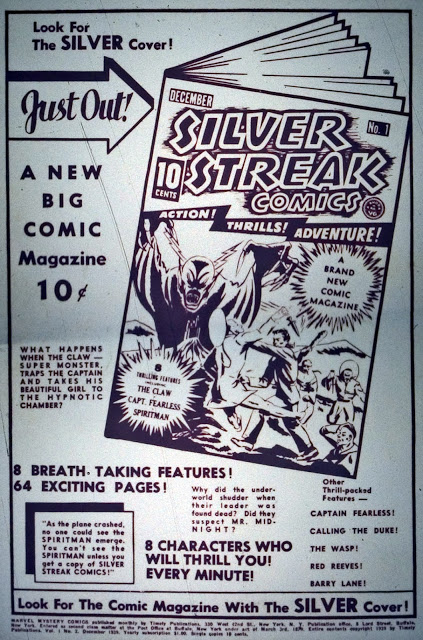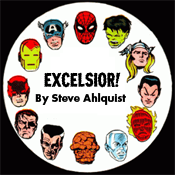One of the greatest guides to the concept of continuity in a specific series is
The DisContinuity Guide: The Unofficial Doctor Who Companion by Paul Cornell, Martin Day and Keith Topping, first put out in 1995.
From my point of view the genius of this work is in the way the authors peel back the layers of a complex text like Doctor Who, and start back at the beginning, when we didn’t know anything about the series or what it would eventually evolve into.
This allows us to see the ways in which the universe was expanded, sometimes carefully, often times not. We get to see undeveloped themes and the earliest examples of new themes.
Like an evolutionary biologist studying our small, brown furred
burrowing human ancestors, we get a look at the way things were without
the baggage of the way things are.
Marvel Comics Golden Age DisContinuity Appendix
 |
| inside front cover of Marvel Mystery Comics 001 |
Why the ad for
Silver Streak Comics appeared in a Timely comic presents an interesting mystery so in this installment we’ll examine
Silver Streak Comics #1, and along the way learn something about the way comics were done in 1939.
Silver Streak Comics 001
Title(s):
The Claw
As Time Stops Mister Midnight
Red Reeves Boy Magician
Captain Fearless
Calling the ‘Duke’
The Wasp
Mesa Justice Barry Lane the Adventure Hunter
Spirit Man
Publication Date:
December 1939
Sources:
Yellow Peril, Jack Cole’s fevered imagination, Edisonades,
Continuity – The Claw
Writer/Artist: Jack Cole
On the Island of Ricca, chemist adventurer Jerry Morris and America’s only female ambassador Eloise Pearsall note that all the inhabitants look beaten and hopeless.
We learn that this is because the island is ruled by the ultimate yellow peril villain, the Claw. The Claw is a giant, (his size varies a bit from panel to panel but he stands anywhere from 20 to 60 feet tall. He is almost a bright yellow (though he’s green on the cover) and has great mystical abilities, including the power to hypnotize the inhabitants of Ricca, making them his miserable thralls. He lives in a European style medieval castle.
We further learn that the Claw only appears when there is a full moon, and it seems that a full moon amplifies his power and even his size!
The Claw uses his power to hypnotize Eloise Pearsal, of course, she being the only white woman within a thousand miles. I’ll talk about the racism in this story in a moment. For now, try to go with it.
Jerry Morris uses his knowledge of chemistry to whip up a formula that will make him immune to any mental of physical attack. It’s made from radium, an early example of radiation granting super powers, something that will become common in 1960s Marvel Comics.
Given an audience with the Claw, Jerry seems unfazed by the monster’s size, powers or appearance. The Claw is equally unimpressed with Morris, and orders him to acclimated, a process of dream hypnosis that acts in some ways like opium. The Claw rewards loyal and fortunate followers with wonderful dreams, and punishes those who fail him with terrible nightmares. Jerry discovers Ambassador Pearsall being “acclimated.”
The radium solution Jerry gave himself ha made him immune to the Claw’s powers, and so Morris is able to escape and give the solution to Ambassador Pearsall. Coming to her senses, we can see the effect of the dreams, because the Ambassador calls them “exquisite.”
The Claw reveals that he intends to make Ambassador Pearsall his Queen, and also sends Jerry Morris out in one of his “leech-boats” a submersible vehicle that allows the Claw to enrich himself through high seas piracy. The artist, Jack Cole, delights in explaining not only the details of the Claw’s plans, but in showing how the technology actually works. It’s this, plus Jerry Morris’s use of chemistry that makes me think of Edisonades. Named for Thomas Edison, Edisonades make us of inventor heroes and spend much of their time explaining how various new scientific inventions might work.
The pirates fill the ship they are pirating with carbon monoxide, which knocks out the crew (though I think it would actually kill them in high enough concentrations.) Having seen enough, Jerry Morris goes into action, fighting off the pirates and taking control of the leech boat.
Jerry rounds up some sailors from the boat the leech-boat crew was pirating to help him stage a raid on the Claw. He gives them all his radium solution, which makes them all impervious to bullets and fire, as well as to the Claw’s hypnosis.
But even though their bodies are immune to fire, their clothing is not, so we are treated to a scene in which Jerry Morris leads a crew of naked sailors against the Claw’s minions! Fortunately Jerry manages to find some clothes before he finds Ambassador Pearsall, who is wearing the crown of a Queen!
The Claw has escaped, but Jerry is right when he notes that we haven’t heard the last of the Claw. He encounters the villain again in the next issue.
Jack Cole, the artist and likely writer of this story, was the editor of Silver Streak Comics. Jack Cole is one of the great artists of the Golden Age of comics, and this is an early, yet impressive work of id-inspired craziness.
The rest of this book is less inspired. There are a few bright spots here and there, but nothing to compare with the opening story. The contents of this issue, like the contents of Marvel Comics #1 and Marvel Mystery Comics #2 were put together by an independent company called Funnies Inc.
After the phenomenal success of
Action Comics #1 and Superman, plenty of other companies wanted to get into the comic book business. Founded by Lloyd Jacquet,
Funnies Inc filled that need by supplying entire comic books ready to be published under your imprint. Funnies Inc. supplied the contents of
Marvel Mystery Comics and
Silver Streak Comics. This is thought to be the reason for the ad exchange in the two books. The ad exchange is, to my knowledge, a singular event in the golden age of comics.
Toward the end of 1940 Jacquet sold off the rights to the character’s appearing in Timely Comics to Goodman. This allowed Goodman to move the production of his comics in house. Jacquet continued to package comics for other companies until 1949.
The rest of Silver Streak Comics #1 is a bit of a disappointment by comparison to the first story.
Continuity – Mr. Midnight
Mister Midnight, a superhero wearing a top hat, cape and domino mask who seems to have the power to “stop time” (though it is unclear how this works in the context of the story because time doesn’t actually seem to stop) is a confusing batch of cliches arranged in an unsatisfactory manner.
When Mr. Midnight yells, “Stop Time!!” the clock stops striking on the seventh stroke of twelve, but what does that mean…
…when time doesn’t stop and everyone runs around as if nothing special happened? Is Mr. Midnight just crazy? The story is so badly told it becomes difficult to follow.
Continuity – Red Reeves
Much better is Red Reeves, Boy Magician, about a little boy who discovers a genii inside a marble when he attempts to shine it. The Genii becomes a slave to Red, and Red accepts his new position as the Genii’s master with no qualms of conscience.
Red’s first wish is for ice cream and cake, which the Genii summons instantly.
The Genii gives Red a magic wand, which he has difficulty controlling at first. This is where “Boy Magician” comes in as opposed to “Boy Who Commands a Genii.”
One interesting bit, the Genii is a Muslim!
Continuity – Captain Fearless
I’ve got to talk about the ugly racism against Asian people in this comic. In “The Claw” by Jack Cole, there’s way too much of the white entitlement and colonialism going on. The Claw is the ultimate, monstrous expression of the “Yellow Peril” most famously embodied in the character of Fu Manchu. However, the Claw is outlandish, more supernatural terror than actual expression of racism (though the racism cannot be denied) and therefore it comes off as wackier than offensive.
Captain Fearless is just offensive. The opening shows the Captain fighting of a mutiny from his entirely Asian crew.
Captured, Captain Fearless hurls racist insults at the mutineers.
Plus the storyline is just stupid. Casual and even violent racism was common in books of this period, and as the United States geared up for war against the Japanese, racism against Asians was particularly ugly (though blacks and African Americans, as well as Native Americans and even the Irish and Italians fared badly as well.) I won’t apologize for it, or make excuses or try to claim that it was a different time and people were less enlightened. I’ll just point it out as an unfortunate defect in these otherwise charming and fun books.
Continuity- The Duke
The Duke is called an “Ace Inspector but he’s really just a dumb, tough cop. He brawls his way through the comic which isn’t exactly terrible, but far from inspired.
Continuity- The Wasp
The Wasp is another domino mask, hat and cloak character. he announces his arrival with some sort of buzzing sound, the better to unnerve his victims, I suppose. It’s tough to tell if he has any actual powers.
Continuity- Barry Lane
Barry Lane is an adventurer who heads out west to stop some cattle rustling because he apparently has nothing better to do. It’s better than the Masked Raider comics appearing in Marvel Mystery Comics. It also in not clear that this series was intended to always be a Western, as the title to an upcoming story, “The Ghost of Kirkwood Castle” seems to belong to a different genre. Hard to tell, because the story doesn’t appear next issue after all.
Continuity- Spirit Man
Writer and artist unknown, it’s hard to find a guy who’s powers make him more omnipotent and omniscient. He watches crimes through a time and space scanner called the “Futurscope.” Then, with the power of “Mistodine Rays” Spirit Malcolm becomes Spirit Man and is sent to the scene of the crime as a phantom than is unseen and can not be hurt, but has the power to shoot and punch people.
As Spirit Man Malcolm can walk through walls and has no problem causing the deaths of criminals who die “like burning rats.”
Spirit Man can make himself visible and can be heard when he chooses. By the way, Spirit Man forces the truck driver to steer over a cliff and die, before forcing a pilot to crash his plane. He doesn’t care who he kills. Ruthless and unnecessarily violent, but fun in an “I can’t believe it” kind of way.
Silver Streak Comics #1 ran an ad for Marvel Mystery Comics #2 on the back inside cover. Here it is:
Next week: Back to the Silver Age with Amazing Fantasy #15 and the first appearance of the Amazing Spider-Man!
Like this:
Like Loading...
Related














































































































































